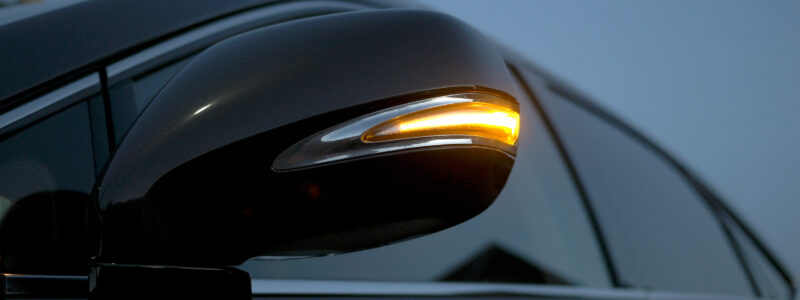Observation, signalling and planning (skills 8 to 13)

8. Mirrors – vision and use
You must know what’s happening around you at all times and act safely on what you see.
You should know:
- how to make use of the mirrors – signal – manoeuvre (MSM) and position – speed – look (PSL) routines
- when to use the mirrors
- why they need to use the mirrors and the importance of regular mirror checks
- how to act on what they see in their mirrors
You also need to know about the different mirrors fitted to the car, including:
- the uses for the interior mirror and the 2 exterior mirrors
- the effect that flat, concave and convex mirrors have, and how to interpret what you see in them
- what areas each mirror covers and where the blind spots are
9. Signals
It’s important to understand, and respond safely to, signals given by other motorists. You should always give clear, well-timed signals to other road users so that they know what you’re planning to do.
You should know:
- why it’s necessary to give signals
- when and how to give signals
- when and how to give arm signals
- when signals are not required
To understand signals given by other people using the road, you should know:
- the significance of other types of signal, including brake, reversing and hazard warning lights
- how to read signals given by traffic controllers such as school crossing patrols
10. Anticipation and planning
These are the core skills of all areas of driving. You should always be aware of what’s going on around you and plan what you need to do in response. Planning ahead can also make your driving more efficient. You can save fuel and wear on your brakes if you ease off the accelerator earlier.
You should be able to:
- use the MSM and PSL routines
- identify hazards from clues and respond to them in good time
- recognise times, places and weather conditions that mean there’s a higher risk
- use scanning techniques to plan ahead and prioritise how you’ll deal with hazards
You also need to be able to anticipate the actions of other road users.
You should be familiar with the risks associated with:
- cyclists
- motorcyclists
- drivers of large vehicles
- pedestrians, including the very young, older people and those with disabilities
- animals
- emergency vehicles
11. Use of speed
Base your speed on factors such as the road conditions, weather, traffic and pedestrians. Always drive within the speed limit.
You should:
- know the national speed limits and restrictions for different types of vehicle and any restricted speed limits for the road you’re on
- adjust your speed to take account of road, weather and traffic conditions
- choose an appropriate speed where there are pedestrians and in traffic-calmed areas
- know the stopping distance for your car in different conditions and how to calculate a safe separation distance from the vehicle in front
12. Other traffic
Most of the time when you’re driving, there will be other traffic on the road. You need to be able to deal safely and confidently when meeting, crossing and overtaking other vehicles.
You should be able to deal with:
- meeting oncoming traffic when there are parked cars or obstructions on your side of the road
- meeting oncoming traffic on narrow roads with passing places
- crossing the path of other traffic when turning right
- overtaking legally and safely
You need to know:
- the MSM and PSL routines
- why and when to give way – you should not cause another road user to slow down or alter their course when they have priority
- the significance of passing places, warning signs, road markings and how to deal with obstructions
- the importance of planning and anticipation, and acting safely on what you see
- how to drive on all road types, including a one-way or two-way road, a three-lane two-way road, a dual carriageway and a motorway
13. Fuel-efficient driving
Everything from the type of car and the fuel it uses to the way in which you drive influences the environment. You should understand how to reduce any negative effects to keep the air we breathe cleaner.
You need to understand how driving affects the environment and be aware of:
- the effect that vehicle exhaust gases have on the climate and health
- how to reduce fuel consumption by changing their driving style
- new technologies offering clean alternatives to fossil fuels
To minimise your effect on the environment, you should know how to:
- reduce your fuel consumption by planning ahead and using the highest possible gear without making the engine struggle
- make sure your car is serviced as per manufacturer’s recommendations and is in a good condition
- check your car’s tyre pressures – tyre pressure can have a significant effect on fuel efficiency
- dispose of vehicle waste (like spent oil, old batteries and used tyres) correctly
Previous page:
Not feeling completely prepared?
Only take your driving test if you’re feeling completely prepared.
You can move your driving test back if you’re not feeling quite ready yet.
It’s free to change your appointment time, as long as you do it at least 10 full working days (Mondays to Saturdays) before your test.